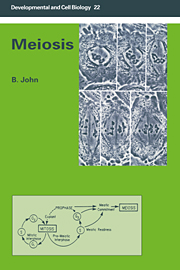Book contents
- Frontmatter
- Contents
- Acknowledgements
- Prologue
- 1 Introduction – multiplication and division
- 2 Modes of meiosis
- 3 Occurrence and timing of meiosis
- 4 Events and mechanisms of meiosis
- 5 Chromosome disjunction
- 6 The genetic control of meiosis
- 7 Sequences and consequences of meiosis
- 8 Evolutionary aspects of meiosis
- Postlogue
- References
- Index
8 - Evolutionary aspects of meiosis
Published online by Cambridge University Press: 21 January 2010
- Frontmatter
- Contents
- Acknowledgements
- Prologue
- 1 Introduction – multiplication and division
- 2 Modes of meiosis
- 3 Occurrence and timing of meiosis
- 4 Events and mechanisms of meiosis
- 5 Chromosome disjunction
- 6 The genetic control of meiosis
- 7 Sequences and consequences of meiosis
- 8 Evolutionary aspects of meiosis
- Postlogue
- References
- Index
Summary
I shall take it for granted not merely that selection tends to favour more fit at the expense of less fit phenotypes, but that the phenotypes which are actually present are more fit than any alternative phenotypes … The force of this axiom is to compel the belief that genetic systems are highly precise adaptations. Otherwise we must believe that they are makeshifts, that several of them may perform the same function equally well and that a particular system has been adopted only by chance.
Graham BellNo attempt to deal with the facts of meiosis would be complete without some consideration of the evolution of the various modes and mechanisms to which the greater part of this monograph has been devoted.
The data summarized in Chapter 6 indicate that all the component parts of the meiotic mechanism are under genetic control and show heritable variation in the form of mutations. Since selection will operate on any set of entities with the properties of heredity, variation and a capacity for multiplication,it has commonly been assumed, as the quote which introduces this chapter also initially assumes, that changes in the character of meiosis stemming from mutation will necessarily reflect adjustments relating to selection for enhanced fitness. Inherent in this assumption is the belief that different meiotic systems have different consequences which allow them to respond to differentselection pressures.
It is certainly possible to demonstrate a response to artificial selection for a number of aspects of meiotic behaviour. Shaw (1971b), for example, was able to alter the mean cell chiasma frequency of male meiocytes by selecting grasshoppers with high and low mean cell chiasma frequencies and using these as parents in experimental crosses.
- Type
- Chapter
- Information
- Meiosis , pp. 304 - 323Publisher: Cambridge University PressPrint publication year: 1990



